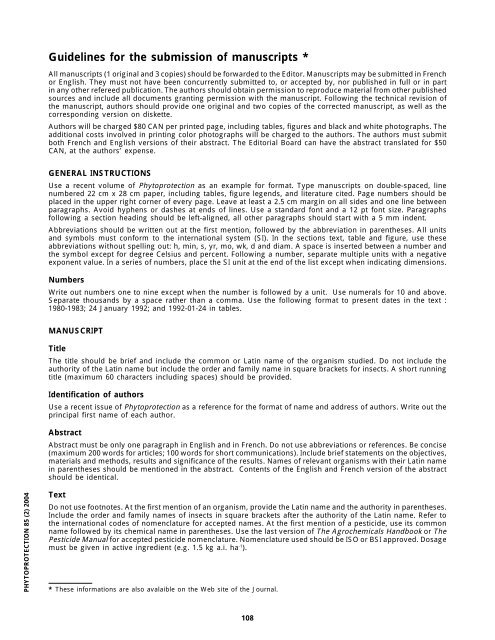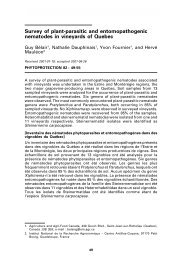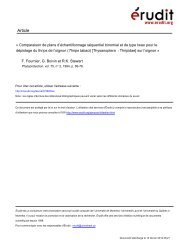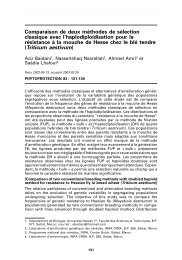Instructions to authors - Revue Phytoprotection Journal
Instructions to authors - Revue Phytoprotection Journal
Instructions to authors - Revue Phytoprotection Journal
You also want an ePaper? Increase the reach of your titles
YUMPU automatically turns print PDFs into web optimized ePapers that Google loves.
Guidelines for the submission of manuscripts *All manuscripts (1 original and 3 copies) should be forwarded <strong>to</strong> the Edi<strong>to</strong>r. Manuscripts may be submitted in Frenchor English. They must not have been concurrently submitted <strong>to</strong>, or accepted by, nor published in full or in partin any other refereed publication. The <strong>authors</strong> should obtain permission <strong>to</strong> reproduce material from other publishedsources and include all documents granting permission with the manuscript. Following the technical revision ofthe manuscript, <strong>authors</strong> should provide one original and two copies of the corrected manuscript, as well as thecorresponding version on diskette.Authors will be charged $80 CAN per printed page, including tables, figures and black and white pho<strong>to</strong>graphs. Theadditional costs involved in printing color pho<strong>to</strong>graphs will be charged <strong>to</strong> the <strong>authors</strong>. The <strong>authors</strong> must submitboth French and English versions of their abstract. The Edi<strong>to</strong>rial Board can have the abstract translated for $50CAN, at the <strong>authors</strong>’ expense.GENERAL INSTRUCTIONSUse a recent volume of Phy<strong>to</strong>protection as an example for format. Type manuscripts on double-spaced, linenumbered 22 cm x 28 cm paper, including tables, figure legends, and literature cited. Page numbers should beplaced in the upper right corner of every page. Leave at least a 2.5 cm margin on all sides and one line betweenparagraphs. Avoid hyphens or dashes at ends of lines. Use a standard font and a 12 pt font size. Paragraphsfollowing a section heading should be left-aligned, all other paragraphs should start with a 5 mm indent.Abbreviations should be written out at the first mention, followed by the abbreviation in parentheses. All unitsand symbols must conform <strong>to</strong> the international system (SI). In the sections text, table and figure, use theseabbreviations without spelling out: h, min, s, yr, mo, wk, d and diam. A space is inserted between a number andthe symbol except for degree Celsius and percent. Following a number, separate multiple units with a negativeexponent value. In a series of numbers, place the SI unit at the end of the list except when indicating dimensions.NumbersWrite out numbers one <strong>to</strong> nine except when the number is followed by a unit. Use numerals for 10 and above.Separate thousands by a space rather than a comma. Use the following format <strong>to</strong> present dates in the text :1980-1983; 24 January 1992; and 1992-01-24 in tables.MANUSCRIPTTitleThe title should be brief and include the common or Latin name of the organism studied. Do not include theauthority of the Latin name but include the order and family name in square brackets for insects. A short runningtitle (maximum 60 characters including spaces) should be provided.Identification of <strong>authors</strong>Use a recent issue of Phy<strong>to</strong>protection as a reference for the format of name and address of <strong>authors</strong>. Write out theprincipal first name of each author.AbstractAbstract must be only one paragraph in English and in French. Do not use abbreviations or references. Be concise(maximum 200 words for articles; 100 words for short communications). Include brief statements on the objectives,materials and methods, results and significance of the results. Names of relevant organisms with their Latin namein parentheses should be mentioned in the abstract. Contents of the English and French version of the abstractshould be identical.PHYTOPROTECTION 85 (2) 2004TextDo not use footnotes. At the first mention of an organism, provide the Latin name and the authority in parentheses.Include the order and family names of insects in square brackets after the authority of the Latin name. Refer <strong>to</strong>the international codes of nomenclature for accepted names. At the first mention of a pesticide, use its commonname followed by its chemical name in parentheses. Use the last version of The Agrochemicals Handbook or ThePesticide Manual for accepted pesticide nomenclature. Nomenclature used should be ISO or BSI approved. Dosagemust be given in active ingredient (e.g. 1.5 kg a.i. ha -1 ).* These informations are also avalaible on the Web site of the <strong>Journal</strong>.108
Use only three levels of section heading in the text.1st level :2nd level :3rd level :MATERIALS AND METHODS(capitals, bold)Determination of infectivity parameters(not capitals, bold)Statistical analysis(not capitals, not bold, italic)Cite each figure and table in the text. Figures and tables must be cited in numerical order. The experimental designmust be always clearly stated. Summary statistics should be followed by estimates of variability.ReferencesEach reference cited in the text must be listed in the reference section, and vice versa. Always double check spellingand details of publication. Use a recent issue of Phy<strong>to</strong>protection for examples of reference citation. Referenceswithin the same parentheses must be cited in alphabetical order and separated by a semicolon. Include all authornames in the reference section.Abbreviate all periodicals using the latest edition of Serial Sources for the BIOSIS Previews® Database. Authornames and the year of publication are in bold character. The first line of each reference is left-aligned and allsubsequent lines are indented 5 mm. Separate author’s names by commas, the last author’s name is precededby a comma and the preposition «and». Insert a period after each initial of an author’s name, do not leave a spacebetween initials. Articles in English, French, Spanish, and German may be cited in their original language. For otherlanguages, use the translated title in square brackets in the citation. Always leave a space before and after thecolon following the volume number.Cite references in alphabetical order by first author’s name. Single-author references precede multi-authored worksby the same main author, regardless of date. Dual <strong>authors</strong>hips with the same first author are listed alphabeticallyby the second author and chronologically thereafter. References having a single author or three or more <strong>authors</strong>are listed chronologically only.TablesStart each table on a separate page. Tables are numbered with arabic numerals followed by a period. Use the samefont and font size as in the text. Do not use vertical border lines. Indicate footnotes by lowercase superscript lettersin alphabetical order. The use of asterisks is limited <strong>to</strong> indicating statistically significant values. Give units ofmeasurement in parentheses on the last line of column headings. Center data within columns on decimal points.Data not available or not applicable are indicated by a double hyphen. Tables should be constructed using tab keys.Never align data with the space bar.Figures and illustrationsFigures are black and white half-<strong>to</strong>ne pho<strong>to</strong>graphs, drawings, or graphs. Figures must be prepared using professionalstandards. Flaws will not be corrected. Pho<strong>to</strong>graphic figures and plates must be submitted in final journalsize. Write author names and figure number on the back of each figure or plate on all originals and review copies.Figures submitted in sizes larger than the following will be reduced: one-column : 80 mm width x 230 mm height;two-columns 172 mm width x 230 mm height.LegendsGroup on a separate page according <strong>to</strong> figure arrangements. If many symbols occur in a figure, include a sectionheaded “Abbreviation” at the end of the legend. Figure numbers are in arabic numerals.GraphsUse the same font size throughout the figure or group of figures. They should have a minimum height of 2 mmwhen reduced <strong>to</strong> final size. Use only capital letters, except for Latin names. Line drawings for curves, bars, etc.should be thicker than axis lines.FiguresComposite figures must be grouped in<strong>to</strong> one plate consisting of glossy pho<strong>to</strong>s butted <strong>to</strong>gether without spacebetween adjacent pho<strong>to</strong>s. Affix on white poster brad, leaving at least 2.5 cm margins on all sides. Each graph orpho<strong>to</strong> within a composite figure or plate should be identified by uppercase letters. The magnification scale of areasand microscope pho<strong>to</strong>graphs must be included in the figure or in the legend.109
Assemble manuscript in the following orderTitle; Name of <strong>authors</strong>; Address of <strong>authors</strong>; Abstract in English and French; Text of manuscript (Introduction,Materials and Methods, Results and Discussion); Acknowledgement; References; Tables; Legends of figures;Figures; Running Title. Do not include a conclusion or summary section. Short communications do not havesections or text headings and must be assembled in the same order as a manuscript. Do not staple.PHYTOPROTECTION 85 (2) 2004110


